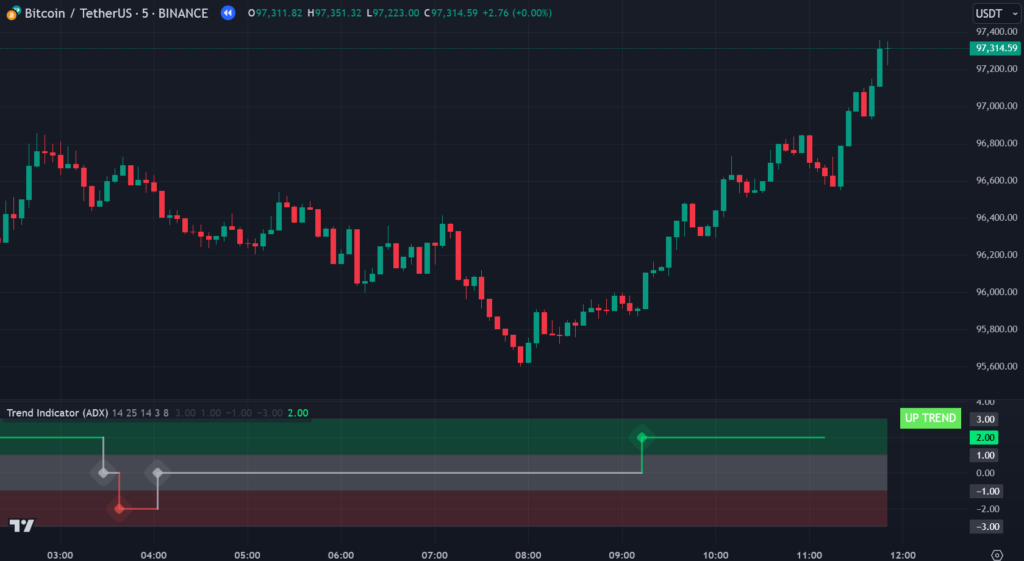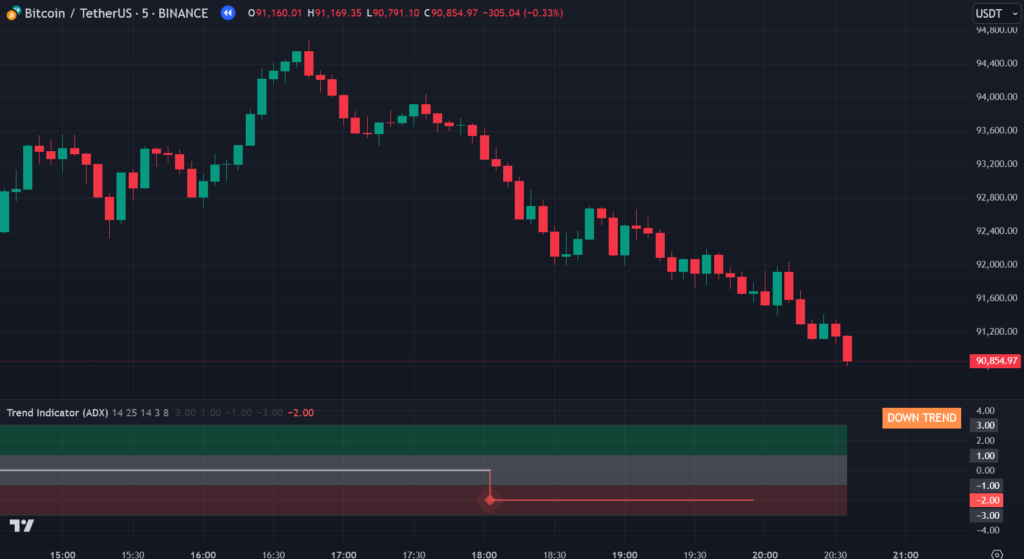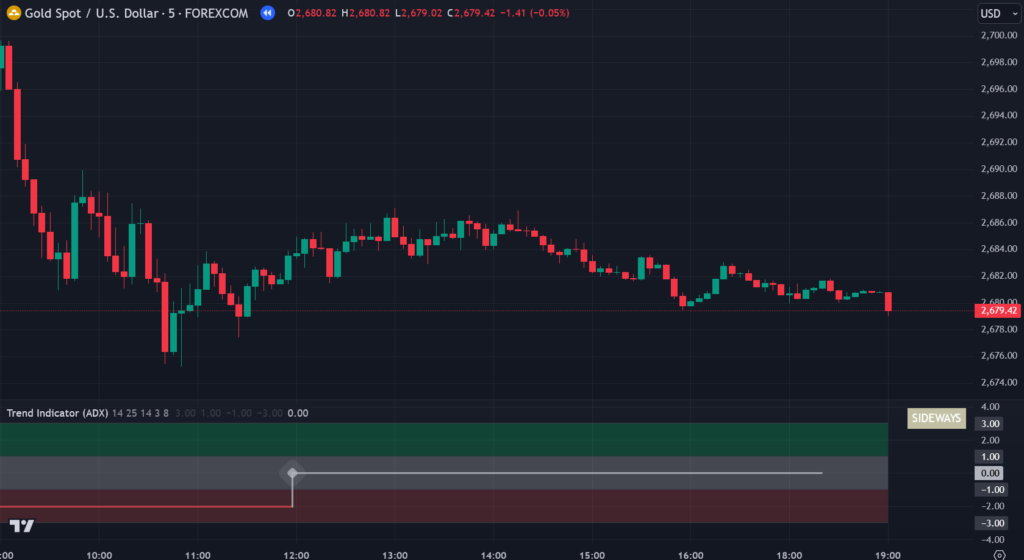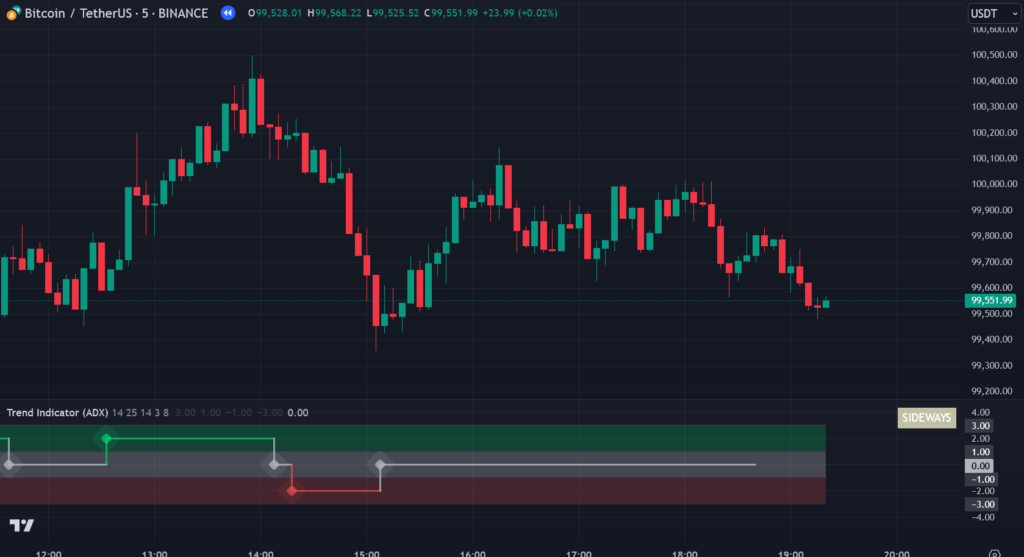🔓 Get All Tools for FREE!
- ✅ Click here to open a trading account using our referral link and start trading.
- 📅 After 7 days of active trading under our referral link, you can get access to all tools in your account.
- ⚠️ Keep trading to keep access free — if you're inactive for 7 days, your access will be removed.
- 👉 Already have an account? You can change the IB (introducing broker) to our referral link ( https://one.exnesstrack.org/a/w7syl3vnjb ) and still qualify!
The Trend Indicator (ADX) is a powerful tool used by traders to analyze market trends and identify whether a market is trending or in a sideways phase. Built using Pine Script on TradingView, this indicator uses the Average Directional Index (ADX) and Directional Indicators (DI) to assess trend strength and direction. Let’s dive into how this indicator works, its features, and how you can use it effectively on TradingView.
What is the ADX Indicator?

The Average Directional Index (ADX) is a technical analysis tool that helps traders gauge the strength of a trend in the market. It is calculated using two components, the Plus Directional Indicator (+DI) and the Minus Directional Indicator (-DI). These two indicators provide information about the price movement in either direction.
🔓 Get All Tools for FREE!
- ✅ Click here to open a trading account using our referral link and start trading.
- 📅 After 7 days of active trading under our referral link, you can get access to all tools in your account.
- ⚠️ Keep trading to keep access free — if you're inactive for 7 days, your access will be removed.
- 👉 Already have an account? You can change the IB (introducing broker) to our referral link ( https://one.exnesstrack.org/a/w7syl3vnjb ) and still qualify!
- +DI measures the strength of the upward price movement.
- -DI measures the strength of the downward price movement.
The ADX value itself, typically ranging from 0 to 100, shows the strength of the trend. A value above 25 generally indicates a strong trend, while a value below 20 suggests a weak or sideways market.
How Does the Trend Indicator (ADX) Work on TradingView?

This Trend Indicator, built using Pine Script on TradingView, dynamically adjusts to market conditions, providing traders with clear and actionable insights. Here’s a breakdown of how it works:
- Trend Classification:
- Uptrend (green): When the Plus DI (+DI) is greater than the Minus DI (-DI), the market is considered to be in an uptrend. The indicator will display a green zone to indicate a bullish trend.
- Downtrend (red): When the Minus DI (-DI) exceeds the Plus DI (+DI), the market is in a downtrend. The indicator will turn the zone red to signify a bearish trend.
- Sideways (gray): When the ADX is below a predefined threshold (usually 20), it means the market is not showing any clear directional movement. This is interpreted as a sideways or consolidating market, and the zone will appear gray.
- Smoothed Trend Oscillator: The Trend Indicator (ADX) includes a smoothed oscillator that provides a smoother trend value on the chart. This dynamic oscillator changes color based on the market’s trend type, making it easy for traders to visually identify whether the market is in an uptrend, downtrend, or sideways.
- Zones Visualization: The Trend Indicator offers a visual representation of market trends in the form of colored zones.
- Uptrend: A green zone is displayed when the market is in an uptrend, signaling to traders that the trend is bullish.
- Sideways: A gray zone is shown when the market is flat or consolidating, suggesting that there is no clear trend.
- Downtrend: A red zone appears when the market is in a downtrend, signaling a bearish movement.
- Trend Status Table: A trend status table is positioned at the top-right corner of the TradingView chart. This table displays the current trend status (Uptrend, Sideways, or Downtrend). The background color of the table changes dynamically according to the trend type, making it even easier for traders to stay updated at a glance.
How to Use the Trend Indicator (ADX) on TradingView

To use this Trend Indicator (ADX) effectively, follow these steps:
- Add the Indicator to Your Chart:
- Open TradingView and go to the chart of the asset you want to analyze.
- In the indicator section, search for “Trend Indicator (ADX)” or the specific name if it’s custom.
- Click on it to add the indicator to your chart.
- Interpret the Trend Signals:
- Pay attention to the color of the zone on the chart.
- A green zone indicates a strong uptrend.
- A red zone signals a downtrend.
- A gray zone suggests a neutral or sideways market.
- Use the Trend Status Table to get a quick overview of the market’s condition in real-time. This table dynamically updates as the trend shifts between uptrend, downtrend, and sideways.
- Pay attention to the color of the zone on the chart.
- Trade Based on Trend Confirmation:
- When the indicator shows a green zone and uptrend, consider looking for buy signals or long trades.
- If the indicator turns red and signals a downtrend, you might want to consider selling or looking for short trade opportunities.
- During sideways or gray zones, it’s often a good idea to wait for clearer trend signals or use range-bound trading strategies.
- Customize the Indicator for Your Strategy: One of the key advantages of using Pine Script on TradingView is the ability to customize the indicator to fit your trading style. You can adjust parameters such as the threshold for the ADX value to change how sensitive the trend classification is, or tweak the visual settings to match your preferences.
Benefits of Using the Trend Indicator (ADX)
- Clear Trend Identification: The Trend Indicator (ADX) simplifies the process of identifying market trends. Whether the market is trending upward, downward, or moving sideways, the indicator clearly shows the current trend, making it easier for traders to make informed decisions.
- Dynamic Visualization: The smoothed trend oscillator and the colored zones offer dynamic visual cues. This visual aid helps traders quickly assess market conditions without having to analyze complex data points manually.
- Real-Time Updates: The trend status table provides real-time updates, allowing traders to stay informed about market shifts and make timely trading decisions.
- Customizable for Any Strategy: By utilizing Pine Script on TradingView, this indicator can be easily customized to suit different trading strategies. Whether you trade stocks, forex, or cryptocurrency, you can adapt the indicator to meet your specific needs.
Conclusion
The Trend Indicator (ADX) built on Pine Script for TradingView is a powerful tool for traders looking to identify the strength and direction of market trends. By using the ADX and Directional Indicators, this indicator provides a clear and dynamic visual representation of the market’s state, helping traders make more informed decisions. Whether you’re a trend-following trader or someone who prefers to avoid sideways markets, this tool offers a versatile solution for traders across all asset classes. Add it to your TradingView chart today and take your trading analysis to the next level!
Pinescript of Trend Indicator (ADX) on TradingView

For access to this indicator, reach out to us at +91 7620658346. We offer expert algorithm development for TradingView, MT4/MT5, and trading bots.
Follow @algo_aakash on Instagram, YouTube, and Twitter for updates.
Disclaimer
The information in this article and any related indicators is provided for educational purposes only. Trading financial markets involves a high level of risk, and there is no assurance of profit. The custom Bollinger Band strategy is based on historical data and technical analysis, which may not accurately reflect future market conditions. Users are encouraged to conduct their own research, evaluate their risk tolerance, and consult with a licensed financial advisor before making any trading decisions. The author and developer of this indicator are not responsible for any losses resulting from the use of this strategy. Please trade responsibly.
Click here to interact with the feature.
🔓 Get This Tool for FREE!
- ✅ Click here to open a trading account using our referral link and start trading.
- 💡 Use coupon code: FREE during checkout.
- 📅 After 7 days of active trading under our referral link, you’ll get access to this tool in your account.
- ⚠️ Keep trading to keep access free — if you're inactive for 7 days, your access will be removed.
- 👉 Already have an account? You can change the IB (introducing broker) to our referral link and still qualify!

0 Comments